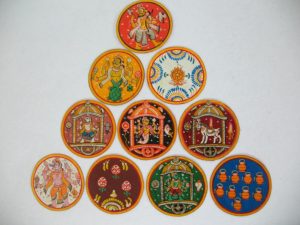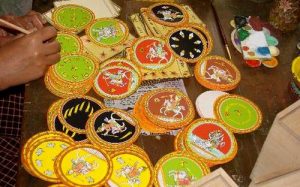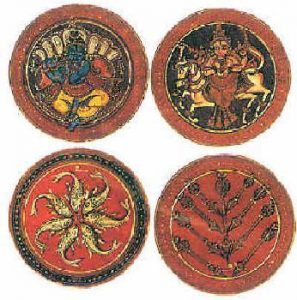Ganjifa refers to a card game which was popular mainly in India, Nepal, and Persia during the ancient times. Ganjifa comes from the Persian word “Ganj” which means “treasure ” in Persian.It was brought to India by the Mughals from their ancestral homeland of Persia(modern day Iran).
The first Mughal emperor Babar is said to have introduced the game in summer of 1527 when he sent a pack of Ganjifa cards to a friend in Sindh. Playing cards were common among the Mughals.They believed that playing cards would foster deep friendship and harmony.
The Maharaja of Mysore, Krishnaraja was also a great admirer of Ganjifa. He employed many artists to paint Ganjifa cards and even got some of the card games painted on the walls of the Jaganmohan Palace in Mysore.
Ganjifa Traditional card
(Image Courtesy-craftandartisans.com)
Ganjifa is played using Ganjifa cards, which are usually circular in shape with a diameter of approximately 8 cm. Usually, 3 players participate in the card game, however, there can be number of participants and the game can be played in pairs too.
(Image Courtesy-youthkiawaaz.com)
The Ganjifa cards are hand painted and the painting on the cards draws inspiration from Indian mythology and epics like Ramayana and Mahabharata.The material used to make the cards during ancient time varied from tortoise shell to wood, palm leaf or stiffened cloth.
Nowadays, the cards are made from cotton cloth. The cotton cloth is put into a mixture of boiled tamarind seeds and gum. It is covered with white clay to toughen it and make the painting on the cloth easier. Finally, the cloth is primed in the shape of a circle.
The background of the cloth is filled with vegetable pigment and later the cloth is painted.The Ganjifa cards are an important artifact because the paintings on the cards capture India’s rich heritage and culture and give us a glimpse of our beautiful past.
Some of the popular variants of Ganjifa card games are:
a)Mughal Ganjifa
b)Dashavatara Ganjifa
c)Ramayan Ganjifa
d)Rashi Ganjifa
f)Mysore Chad Ganjifa
g)Akbar’s Ganjifa
(Image Courtesy-thehindu.com)
The card game and the art of painting the Ganjifa cards is slowly vanishing as there are no royal patrons and very few buyers of the cards in modern times. The cards receive a stiff competition from the western style printed cards which are cheaper and easy to make unlike the meticulous hand-painted Ganjifa cards. Only a handful of Ganjifa artists are left who can make these cards and they work tirelessly to prevent this precious heritage from vanishing.





